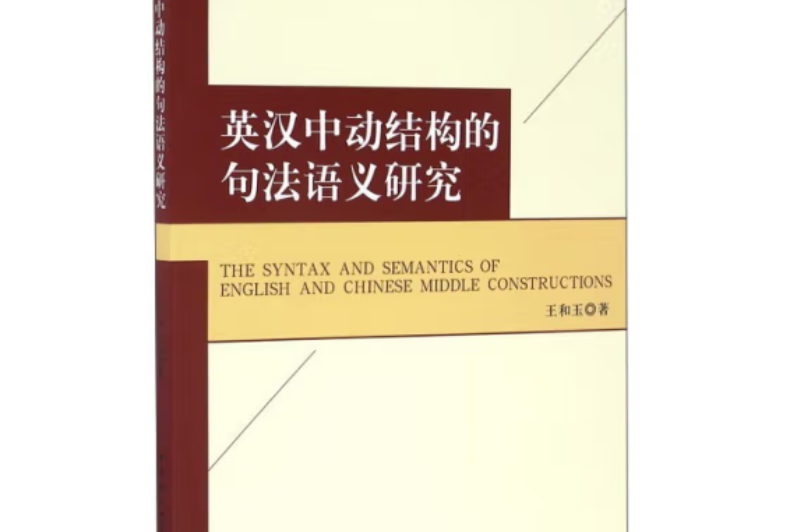《英漢中動結構的句法語義研究:The Syntax and Semantics of English and Chinese Middle Constructions》是2016年中國社會科學出版社出版的圖書,作者是王和玉。
基本介紹
- 中文名:英漢中動結構的句法語義研究:The Syntax and Semantics of English and Chinese Middle Constructions
- 作者:王和玉
- 出版社:中國社會科學出版社
- 出版時間:2016年11月1日
- 開本:16 開
- 裝幀:平裝
- ISBN:9787516190234
內容簡介,圖書目錄,
內容簡介
《英漢中動結構的句法語義研究》是在生成句法理論框架下對英漢中動結構的簡探索。
中動結構關涉不同句式,呈現獨特的句法語義特點。
如何將表面不同的各種句式納入統一的句法結構,並且將其句法語義特點大程度地在結構上進行詮釋?該研究嘗試回答四個問題:(Ⅰ)中動句的語法主語為何不允準施事論元?(Ⅱ)中動句“修飾語要求”的實質是什麼?(Ⅲ)何種句法機制使得中動句體現非事件性?(Ⅳ)中動句的話題效果和評價意義在句法上何以體現?
圖書目錄
Acknowledgements
Chapter One General Introduction
1.1 A Brief Survey of Middles
1.2 Syntactic and Semantic Properties of Middles
1.3 Identifying Middles in English and Chinese
1.4 A Critical Review of Syntactic Study on Middles
1.4.1 The Lexical Approach
1.4.2 The Syntactic Approach
1.4.3 The Parameterized Approach
1.4.4 The Minimalist Approach
1.4.5 The Semantic Approach
1.4.6 Summary
1.5 Research Questions
1.6 Overview of Our Core Assumptions
I.7 Layout of the Book
Chapter Two Theoretical Preliminaries
2.1 Type and Token
2.2 Theta Features and Syntactic Derivation
2.3 Feature Inheritance from C to T
2.4 Agree
2.4.1 Agr as Functional Heads
2.4.2 Agree as Local Syntactic Relation
2.4.3 A Feature-Sharing Version of Agree
2.5 Summary
Chapter Three A [uC]-Featured verb Analysis of Middle Predicates
3.1 Theta Relations and Syntactic Derivation
3.1.1 Lexicalist vs.Non-Lexicalist Debate
3.1.2 Theta Roles as Theta Features
3.l.3 The Light verb and Theta Features
3.1.4 Valuing Theta Features in SD
3.1.5 Summing Up
3.2 Theta Relations in Middle Predicates
3.2.1 The Responsibility Reading and Causative Analysis
3.2.2 A [ uC] -Feature verb Analysis
3.2.3 Merits of the [ uC] -Featured verb Analysis
3.3 English Middles Under the [ uC]-Featured verb Analysis
3.3.1 Patient-Subject Middles
3.3.2 Adjunct-Subject Middles
3.3.3 Agent as Non-External Argument
3.3.4 Summing Up
3.4 Chinese Middles Under the [ uC] -Featured verb Analysis
3.4.1 Patient-Subject Middles
3.4.2 Adjunct-Subject Middles
3.4.3 Middle Status of "NP + V-qilai + AP" Constructions
3.4.4 Summing Up
3.5 Extension of the [ uC]-Featured verb Analysis
3.5.1 Other Constructions Involving the [ uC] -Featured verb
3.5.2 Reflexive Middies in Romanic Languages
3.5.3 Middles and Ergatives
3.5.4 Reflection on the Voice Category
3.6 Summary
Chapter Four An [iMod]-Featured TMOD Analysis of Middle Clauses
4.1 Modals and TP
4.1.1 Significance of the Functional Category T
4.1.2 Modal Projection as TP
4.1.3 Modal Auxiliaries as an [ iMod] -Featured Defective TMOD
4.2 TMOv and the Davidsonian Event Argument in Middle Clauses
4.2.1 The Davidsonian Event Argument
4.2.2 Licensing Condition of the Davidsonian Event Argument
4.2.3 Suppression of the Event Argument by the [iMOD] -Featured TMOD
4.3 Modality in Middle Clauses
4.3.1 Definition and Classification of Modality
4.3.2 Epistemic and Root Modality
4.3.3 Modality Realization in Middle Clauses Through Agree
4.4 [ iMOD]-Featured TMoD Analysis of English and Chinese Middle Clauses
4.4.1 TMOD Analysis of English Middle Clauses
4.4.2 TMOo Neng/Ke (can) in "NP + Neng/Ke + V" Sentences
4.4.3 TMoo Hao (good) in the "NP + Hao + V" Construction
4.4.4 TMOD Nan/Yi (difficult~easy) in "NP + Nan/Yi + V" Sentences
4.4.5 The Null TMOD in the "NP + V-qilai + AP" Construction
4.4.6 Summing Up
4.5 Extension of the [ iMOD]-Featured TMD Analysis
4.5.1 Episodic Middles in English and Chinese
4.5.2 Notional Passives in Chinese
4.5.3 Reflection on the English Tense System
4.6 Summary
Chapter Five The Topic Effect in Middle Constructions
5.1 Topic Status of the Sentence-Initial NPs in Middle Clauses
5.1.1 Categorical Sentence vs.Thctic Sentence
5.1.2 Individual Level Predicates vs.Stage Level Predicates
5.1.3 Middles as Categorical Sentences and Individual Level Clauses
5.1.4 Participant Topic and TMoD
5.2 Feature DONATE from C to TMoD in the Middle Structure
5.2.1 Feature Inheritance Mechanism
5.2.2 Feature DONATE in Derivation of the Middle Structure
5.2.3 Combination of A-Movement and A' -Movement
5.2.4 Overlap of Categorical Topic and Grammatical Subject
5.3 Middle Clauses as Topic Sentences
5.3.1 English Middle Clauses as Topic Sentences
5.3.2 Chinese Middle Constructions as Topic Sentences
5.4 Advantages of the Topicalization Analysis
5.5 Extension of the Topicalization Analysis
5.5.1 Dissolving Impersonal Middle Clauses
5.5.2 Reflection on the Subject vs.Topic Debate
5.6 Summary
Chapter Six The Adverbial Requirement in Middle Constructions
6.1 Previous Accounts for the Adverbial Requirement
6.1.1 Adverbial Requirement as an Intriguing Problem
6.1.2 Various Perspectives to the Adverbial Requirement
6.1.3 Critical Evaluation
6.2 Our Account——A Semantic and Morph-Syntactical Requirement
6.2.1 Adverbial Appearance as Effect of the [ uC] -Featured Light verb
6.2.2 Modal, Negation, Focus as Semantic Operators in the T-Domain
6.2.3 Morpho-Syntactic Realization of the Semantic Operators
6.2.4 Summing Up
6.3 Adverbials in English Middle Constructions
6.3.1 The Allowable Adverbials
6.3.2 Re-Examining the Subtypes
6.4 Are Adverbials Required in Chinese Middle Constructions?
6.4.1 Overt TMOD as Morpho-Syntactic Operators
6.4.2 An Adjectival Requirement in the "NP + V-qilai + AP" Construction
6.4.3 Summing Up
6.5 Reflection on Merger of Adverbials
6.6 Summary
Chapter Seven Conclusion
7.1 Summarizing the Syntax and Semantics of Middle Constructions
7.2 Significance of the Study
7.3 Limitations and Questions for Further Research
References
List of Abbreviations

